|
|
BREEDS OF CATTLE
INDIGENOUS BREED
Indigenous Breeds are classified under three groups based on utility / purpose.
a) Milch breeds / Milk breeds
b) Dual Purpose breeds
c) Draught breeds
Milch Breeds / Milk Breeds:
The cows of these breeds are high milk yields and the male animals are slow or poor work animals. The examples of Indian milch breeds are shahiwal, Red Sindhi, Gir and Deoni The milk production of milk breeds is on the average more than 1600 kg per lactation
Dual Purpose Breeds:
The cows in these breeds are average milk yielder and male animals are very useful for work. Their milk production per lactation is 500 kg to 150 kg. The example of this group is Ongole, Hariana, Kankrej, Tharparker, Krishna valley, Rathi and Goalo Mewathi.
Draught Breeds:
The male animals are good for work and Cows are poor milk yielder are their milk yield as an average is less than 500 kg per lactation. They are usually white in color. A pair of bullocks can haul 1000 kg. Net with an iron typed cart on a good road at walking speed of 5 to 7 km per hour and cover a distance of 30 - 40 km per day. Twice as much weight can be pulled on pneumatic rubber tube carts. The example of this group Kangayam, Umblacherry, Amritmahal, Hallikar.
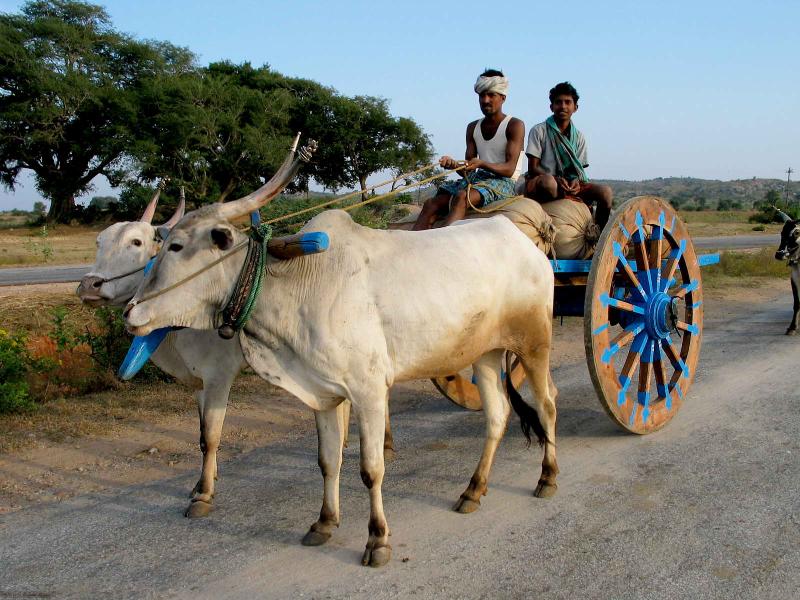 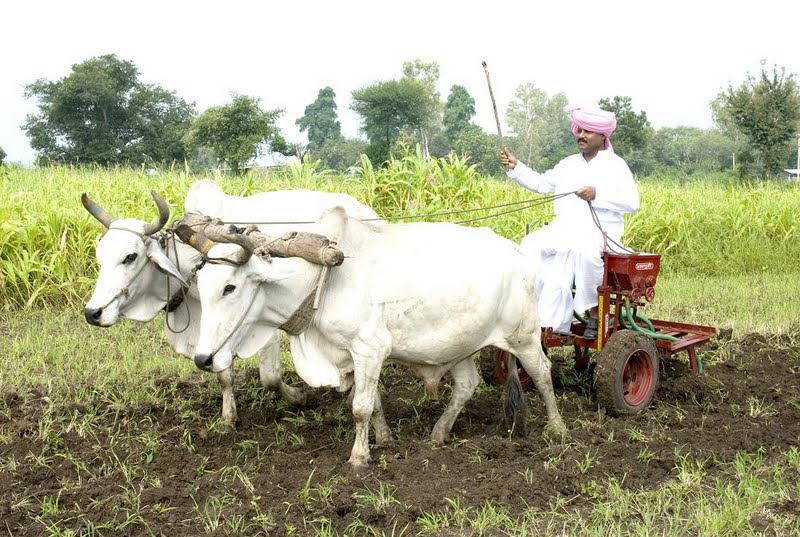
Cart Pulling Bull & Ploughing Bull
Exotic breed – Milch – Jersey, Holstein Friesian
Milch Breed
Red Sindhi
-
Hailing from the Kohistan, Sindh province in present Pakistan, this breed is one of the most distinctive cattle breeds of india.
-
Mainly available in Punjab, Haryana, Karnataka, Tamil Nadu, Kerala and Orissa.
-
Under good management conditions the Red Sindhi averages over 1700 kg of milk after suckling their calves but under optimum conditions there have been milk yields of over 3400 kg per lactation.
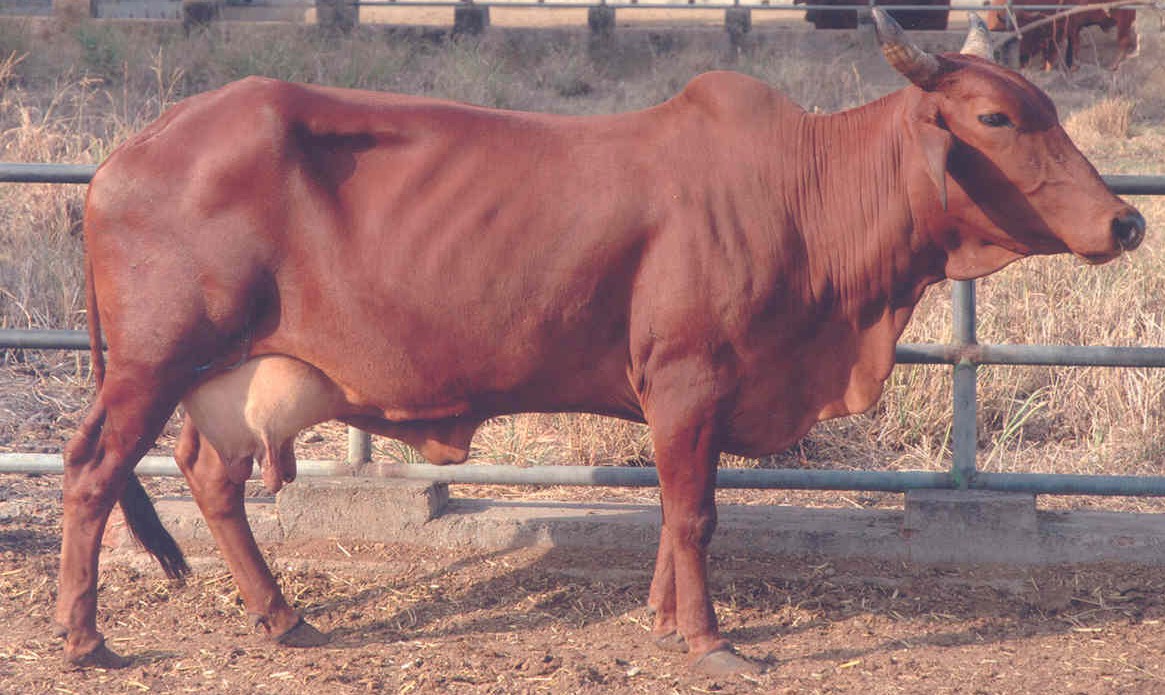
Red Sindhi
Sahiwal
-
Originally Belonging to the Montgomery district of Present Pakistan
-
Mainly found in Punjab, Haryana, U.P, Delhi, Bihar and M.P.
-
Milk yield – Under village condition :1350 kg
-
Milk yield – Under commercial farms: 2100 kg
-
Age at first calving -32-36 months
-
Calving interval – 15 month
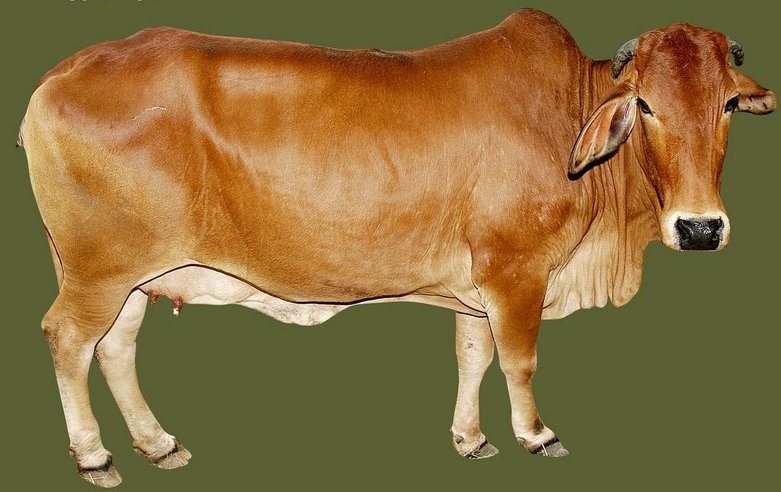
Sahiwal
Gir
-
Mainly found in Gir forest areas of South Kathiawar
-
Gir Cows are good Milk – yielder
-
Milk yield – Under village condition : 900 kg
-
Milk yield – Under commercial farms: 1600 kg
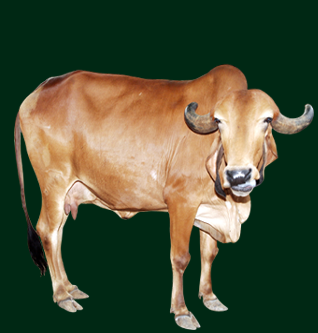
Gir
Deoni
Milch and Draught breeds
Hariana
-
Mainly found in Karnal, Hisar and Gurgaon district of Haryana, Delhi and Western M.P Milk yield –1140 -4500 kgs
-
Bullocks are powerful for road transport and rapid ploughing
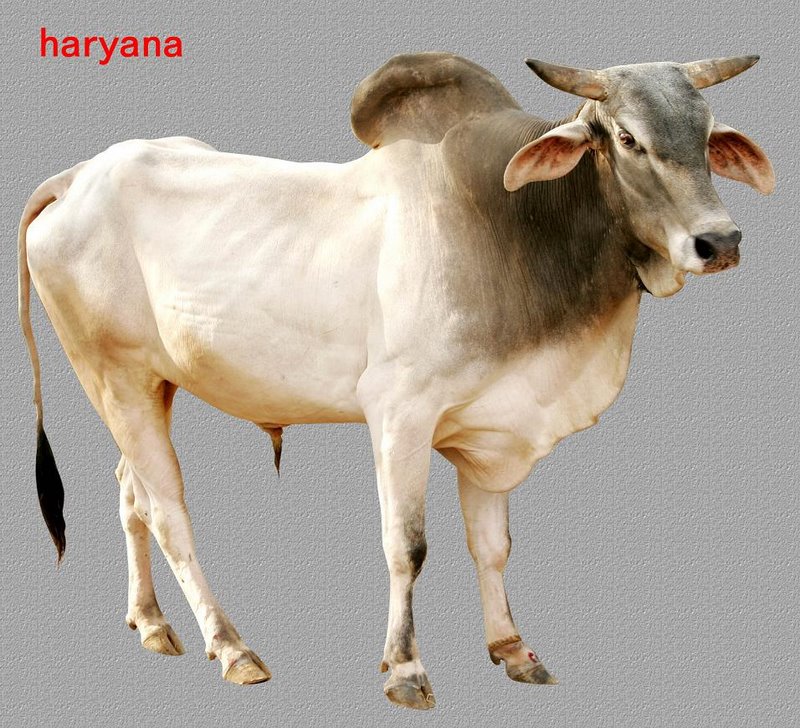
Hariana
Tharparkar
-
Mainly found in Jodhpur, Kutch and Jaisalmer
-
Milk yield – Under village condition :1660 kg
-
Milk yield – Under commercial farms: 2500 kg
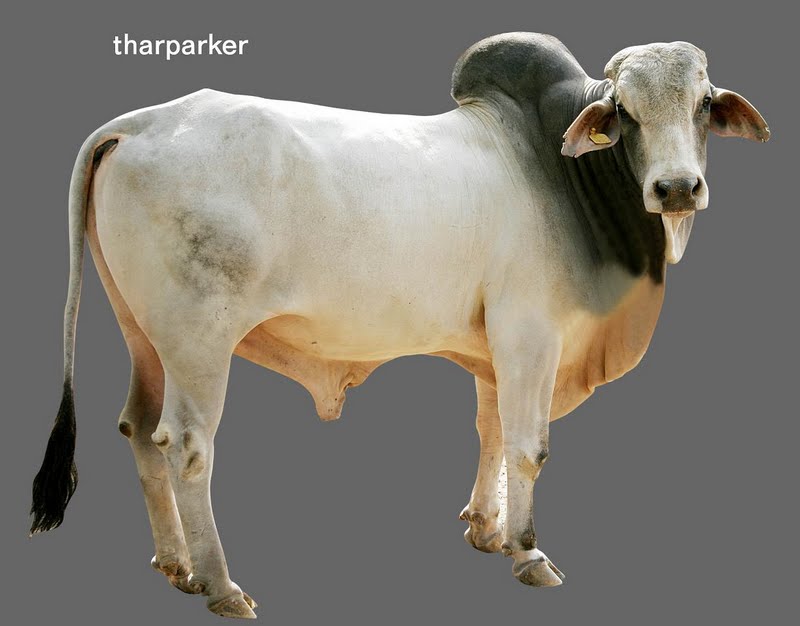
Tharparkar
Kankrej
-
Mainly found in Gujarat
-
Milk yield – Under village condition :1300 kg
-
Milk yield– Under commercial farms : 3600 kg
-
Age at first calving -36 to 42 months
-
Calving interval – 15 to 16 months
-
Bullocks are fast, active and strong. Good for plough and cart purpose
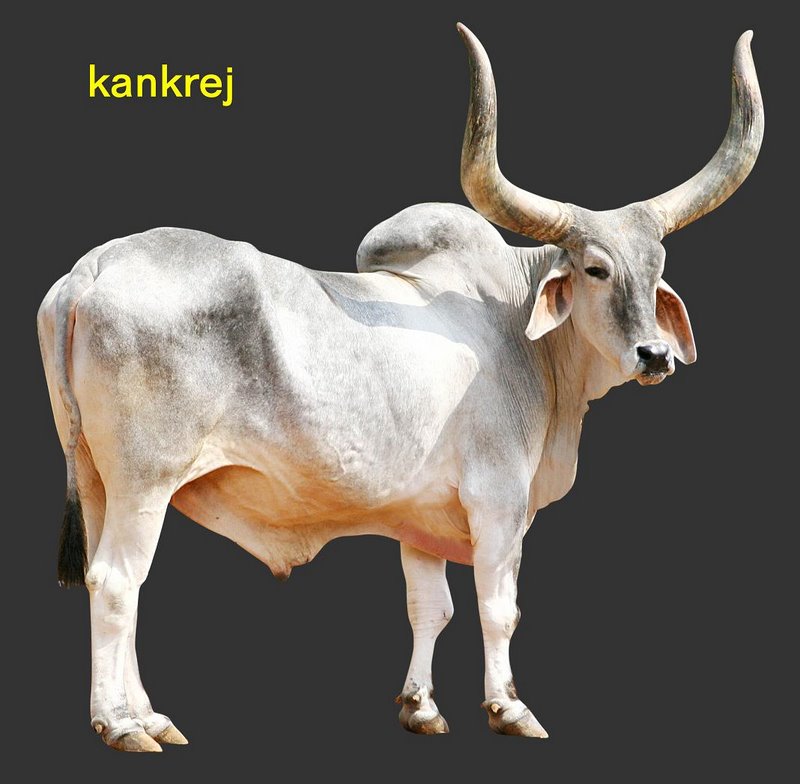
Kankrej
Draught Breeds
Kangayam
-
This breed, in its native area, is also known by other names of Kanganad and Kongu though the name Kangayam is well-known. These cattle are bred in the southern and southeastern area of the Erode district of Tamilnadu in India.
-
Mainly found in Coimbatore, Erode, Namakkal, Karur and Dindigul districts of Tamil Nadu.
-
Best suited for ploughing and transport. Withstands hardy conditions.
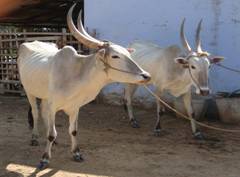
Kangayam
Amritmahal
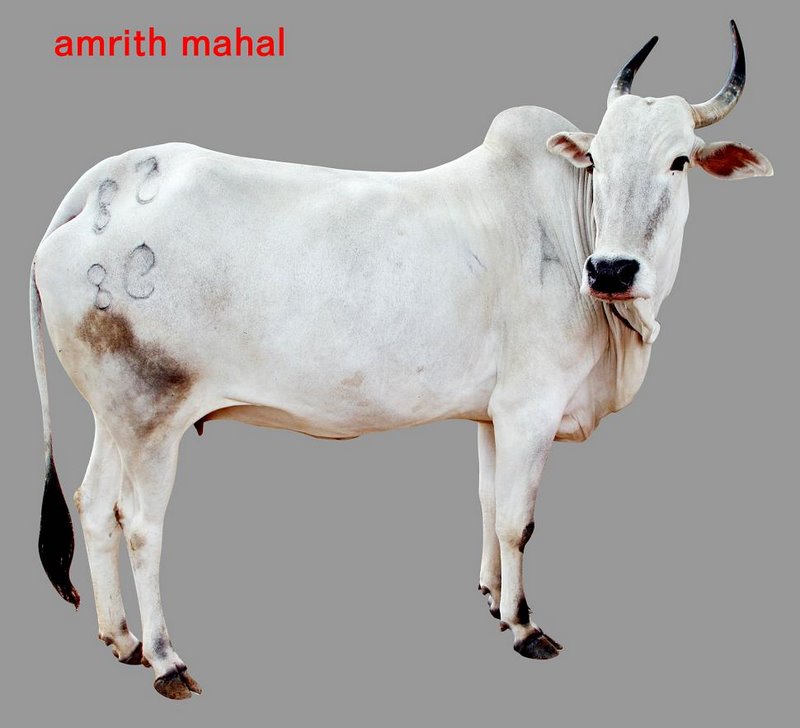
Amritmahal
Hallikar
-
Mainly found in Tumkur, Hassan and Mysore districts of Karnataka
-
Bullocks are strong, well spirited, quick and steady in the field as well as on road.
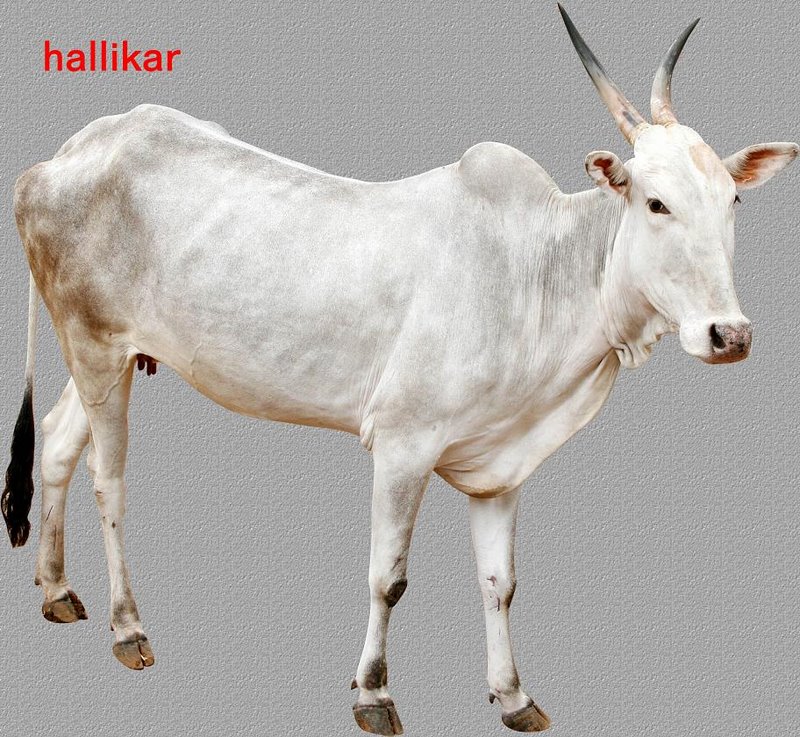
Hallikar
Umblacherry
Origin: Tanjore district in Tamilnadu.
Distinguishing characters:
-
This breed has similar characters as kangayam.
-
Bulls are fearly temperament. They are used for ploughing in Thanjore delta area.
-
Calves are red in colour when born and become grey in colour after 6 months of age.
-
Cows are poor milker with average milk yield of 300 kg/lactation.
-
Male animals are good for hard work.
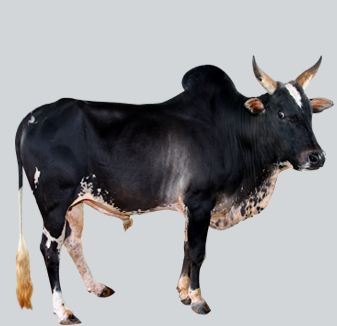
Umblacherry
Photo Source: http://eng.gougram.org/photo-gallery/?album=IndianCowBreeds
EXOTIC BREEDS
Jersey
Origin: This breed was developed from the island of jersey in the English channel off the coast of France.
Distinguishing Characters:
-
The Jersey is one of the oldest dairy breeds, having been reported by authorities as being purebred for nearly six centuries
-
The color in Jerseys may vary from a very light gray or mouse color to a very dark fawn or a shade that is almost black. Both the bulls and females are
-
commonly darker about the hips and about the head and shoulders than on the body.
-
Age at first calving : 26-30 months
-
Intercalving – 13-14 months
-
Milk yield – 5000-8000 kg
-
Dairy milk yield is found to be 20 liter whereas cross bred jersey, cow gives 8-10 liter per day.
-
In India this breed has acclimatized well especially in the hot and humid areas
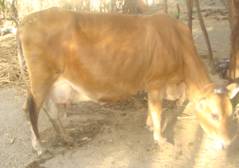
Jersey
Holstein Friesian
Origin: This breed is originated in Holland.
Distinguishing Characters:
-
Holsteins are large, stylish animals with color patterns of black and white or red and white.
-
Holstein heifers can be bred at 15 months of age, when they weigh about 800 pounds. It is desirable to have Holstein females calve for the first time between 24 and 27 months of age.
-
Milk yield - 7200-9000 kg.
-
This is by far the best diary breed among exotic cattle regarding milk yield. On an average it gives 25 liter of milk per day, whereas a cross breed H.F. cow gives 10 - 15 liter per day.
-
It can perform well in coastal and delta areas.
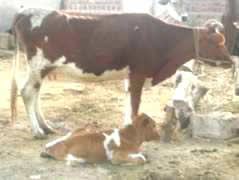
Holstein Friesian
CROSS BREEDING:
It is mating of animals of different breeds. Cross breeding is followed for breeding animals for milk production and meat production. In India zebu breeds of cows and nondescript cows are crossed with exotic breeds like Holstein Friesian, Brown Swiss and Jersey bulls or their semen, to enhance the milk production potential of the progeny.
-
As selection is a slow process of genetic improvement cross breeding has been taken up as the national breeding for improving milk production in India . Cross breeding word was initiated at NDRI Bangalore, Live Stock farm and Allahabad Agricultural Institute. At present cross breeding work is going on at Military dairy farms, NDRI Karnal, All India coordinated Research project son Cattle, Collaboration projects like Indo-Swiss, Indo Australian, Indo-Danish, projects and also in the field in farmer’s he. The feeding and management of the crosses would be better, to enable them to express their production potential.
-
In general the cross breeds were found to have higher birth weight, faster growth rate, earlier age at first calving, higher weight ; at first calving, higher lactation yield, longer lactation period) shorter service period, dry period and milk production and breeding efficiency.
-
There are several exotic breeds being used in cross breeding programme, namely Holstein Friesian, Jersey, Brown Swiss and Reddane Holstein Friesian is found to be best suited for fluid milk supply in cities, and where higher feed inputs can be provided and where the temperature is temperate or sub-tropical. In contrast Jersey crosses are ideal when the milk is meant for product manufacture and where feed inputs are limited and the climate is trop.
Advantage:
-
The desirable characters of the exotic parent are transmitted to the progeny which the indigenous parent does not have.
-
In India Cross-breeding and cows is done by using the exotic bulls and the progeny inherit the desirable characters of the parent like high milk yield early maturity, higher birth weigh of calves, better growth rates, better reproductive efficiency and indigenous parents characters like, heat tolerance, disease resistance ability to thrive on scanty feeding and coarse fodder etc.
-
In pairs the way to evolve new breeds with desirable characters. Hybrid vigour is made use of in the progency.
-
Results are seen more quickly in characters like milk yield in the crossbred progeny.
Disadvantages:
-
The breeding merit of cross breed animals may be slightly reduced.
-
Cross breeding requires maintenance of two or more pure breeds inorder to product the cross breeds.
(Source: http://bieap.gov.in/DairyAnimalManagementTheory.pdf)
Cross-breed cattle
The crossbreeds are having exotic inheritance from Jersey, Brown Swiss or Holstein Friesian or a combination of these different breeds. Jersey breed is known for the milk fat percent and Holstein for the high quantity of milk.
Cross-breed cattle in India
| S. No |
Name of the Breed |
Native breed |
Specific region |
Assembling centre |
Remarks |
1 |
Brown Swiss |
Switzerland |
- |
India, Pakistan & other Asian
countries |
Dairy breed |
2 |
Holstein Friesian |
Holland |
Province of North Holland and West Friesland |
Throughout the country
(crossbreds) |
Dairy breed |
3 |
Jersey |
British Isles |
Island of Jersey |
Crossbreds available in
all states. |
Dairy breed |
(Source: National Dairy Development Board )
Indigenous cattle of India
S. No. |
Breed |
Habitat/Main State |
Breeding Tract
Districts |
Assembling Center |
Areas of
demand |
Remarks |
1 |
Hallikar |
Karnataka |
Tumkur, Hassan & Mysore |
Dodbalapur, Chickballapur, Harikar, Devargudda, Chikkuvalli, Karuvalli, Chittavadgi (T.N.) North Arcot (T.N.) Hindupur, Somaghatta, Anantpur (A.P.) |
Dharwar, North Kanara, Bellary (KT) Anantur & Chittur (A.P.), Coimbatore North Arcot, Salem (T.N.) |
Draught breed |
2 |
Kangayam |
Tamil Nadu |
Erode |
Avanashi, Tirppur, Kannauram, Madurai Athicombu |
Southern Districts of Tamil Nadu |
Draught breed |
3 |
Red Sindhi |
Pakistan All parts of India |
- |
- |
- |
Dairy breed |
4 |
Tharparkar |
Pakistan(sind) |
Umarkot, Naukot, Dhoro Naro Chor |
Balotra (Jodhpur), Puskar (Ajmer), Gujarat State |
- |
Dairy breed |
5 |
Vechur |
Kerala |
- |
Vaikom, Mannuthy (Kerala State) |
- |
- |
(Source: National Dairy Development Board)
| |













